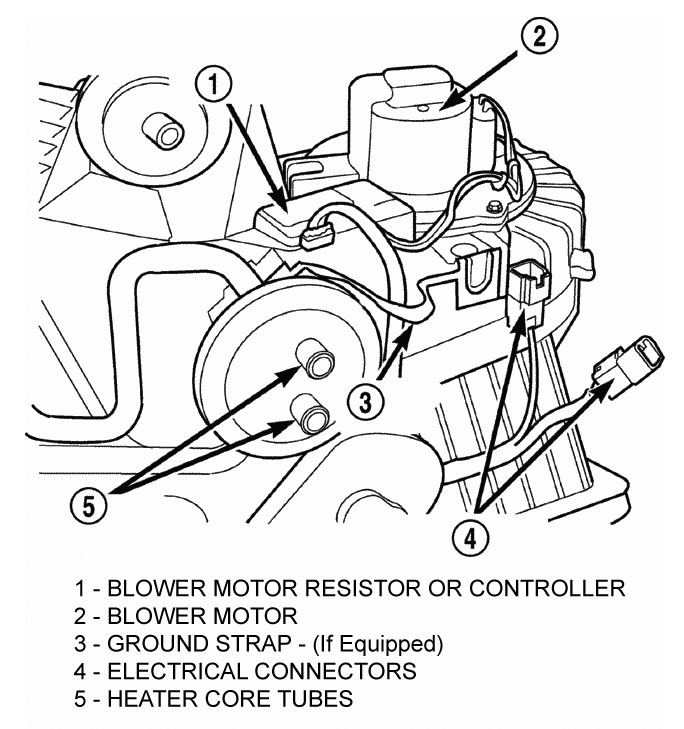Blower motor diagnostics
1. FUSE: Blower motor power feed circuit fuse may be blown.
2. COLD ENGINE LOCK OUT FEATURE: Some models with auto temp control (ATC) incorporate a feature involving the body control module that prevents blower motor operation when engine coolant temp is below approx (98F) degrees. This feature is cancelled if manual blower motor fan speed is selected.
3. CIRCUIT WIRING AND CONNECTORS: Check all related circuit wiring / connectors / power feed and ground connections. Check for poor pin connections and chafed wiring harness (rub through) causing short to power or ground. Check blower motor control switch (fan switch) operation. Check blower motor relay.
4. INSTRUMENT PANEL SIDE BOLTS: Some models use the large bolts at each end of the instrument / dash panel to provide ground path to the chassis. Check for secure and clean connection at instrument panel side bolts.
5. POWER MODULE: Some models equipped with auto temp control (ATC) use a power module to engage the blower motor relay. Check ATC power module operation. Replace ATC power module as required. IMPORTANT Verify correct wiring harness and resistor card is used for proper blower motor operation.
6. IGNITION SWITCH: Some models use the ignition switch to engage the blower motor relay. Defective ignition switch may allow the blower motor to operate with the ignition off. Check ignition switch operation and related circuit wiring to blower motor relay.
7. BLOWER MOTOR RESISTOR: Disconnect and isolate the battery negative cable and unplug the wire harness connector from the blower motor resistor. Check for continuity between each of the blower motor switch input terminals of the resistor and the resistor output terminal. In each case there should be continuity. If OK, repair the wire harness circuits between the blower motor switch and the blower motor resistor or blower motor as required. If not OK, replace the faulty blower motor resistor.
The blower motor circuit resistor will disengage the power feed to the blower motor if high circuit load is detected. A blown resistor may indicate interference or drag is being placed on the blower motor fan or the blower motor has an internal problem. Blower motor may operate on one speed only if resistor is blown on some models. Suggest blower motor amperage draw test. Amp draw should be approx (13-17) amp when blower is operating on high mode. Check all related circuit wiring and replace blower motor if higher than normal amperage draw is detected.
8. BLOWER MOTOR FAN: Check blower motor fan (squirrel cage) for debris or damage. Verify fan is secure to blower motor shaft.
9. BLOWER MOTOR: Check blower motor operation manually with jumper test wires to power source and ground. Replace blower motor if internal problem is suspected.
10. BLOWER MOTOR SWITCH: Check for battery voltage at the fuse in the Power Distribution Center (PDC). If OK, go to Step 2. If not OK, repair the shorted circuit or component as required and replace the faulty fuse.
(step 2) Turn the ignition switch to the Off position. Disconnect and isolate the battery negative cable. Remove the a/c heater control from the instrument panel. Check for continuity between the ground circuit cavity of the a/c heater control wire harness connector and a good ground. There should be continuity. If OK, go to Step 3. If not OK, repair the open circuit to ground as required.
(step 3) With the a/c heater control wire harness connector unplugged, place the a/c heater mode control switch knob in any position except the Off position. Check for continuity between the ground circuit terminal and each of the blower motor driver circuit terminals of the a/c heater control as you move the blower motor switch knob to each of the four speed positions. There should be continuity at each driver circuit terminal in only one blower motor switch speed position. If OK, test and repair the blower driver circuits between the a/c heater control connector and the blower motor resistor as required. If not OK, replace the faulty a/c heater control unit.
WJ blower motor resistor / controller location
Special thanks to BillyZJ from JeepsUnlimited.com for some of the images and connector repair information used on this page.







 Reply With Quote
Reply With Quote